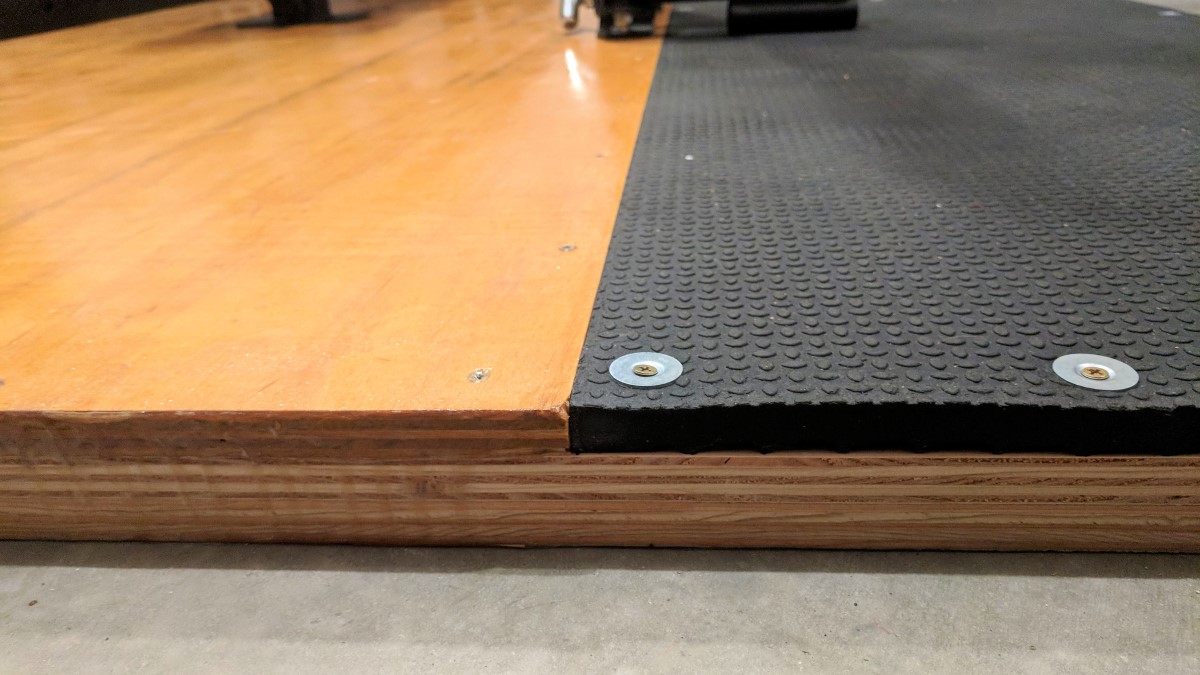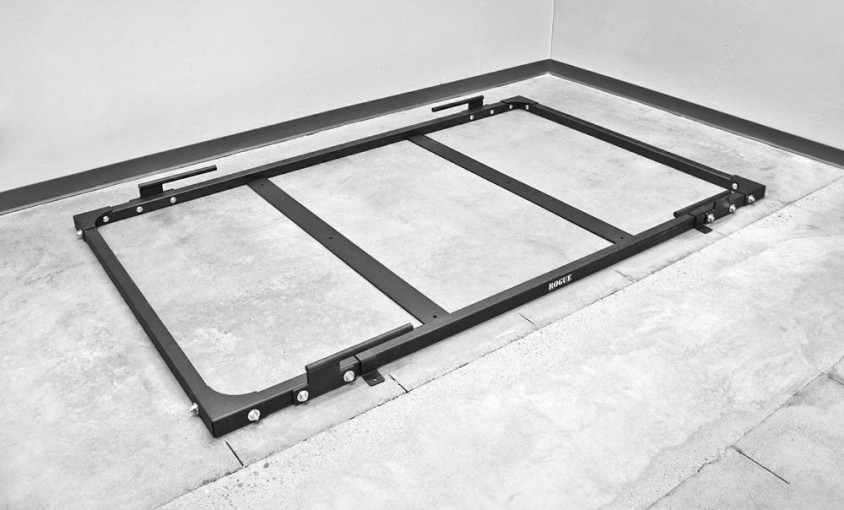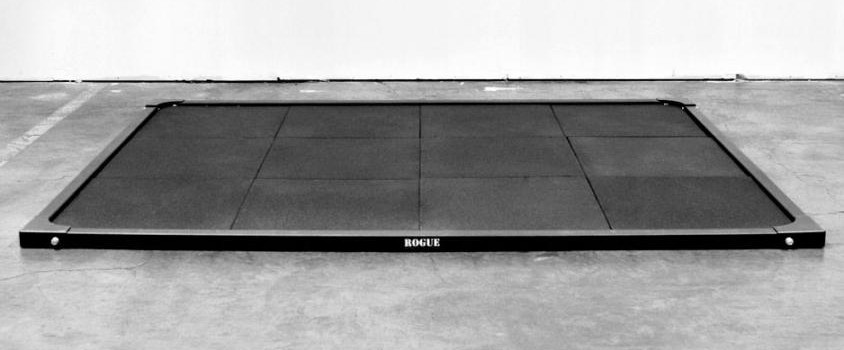Updated for 2022 with current prices and information on a couple platforms, and added one from Valor Fitness.
Table of Contents
Why Do You Need a Lifting Platform?
To Protect Your Floor
Rubber gym flooring protects your concrete garage floor, but even 3/4″ rubber might not be enough. Not all concrete is created equal. If the builder cheaped out, dropped olympic lifts will start pulverizing the concrete or create cracks. Dropping weights is significantly harder on concrete than your car rolling into the garage with its soft rubber tires, even when you add in the factor of extra rubber protecting the concrete.
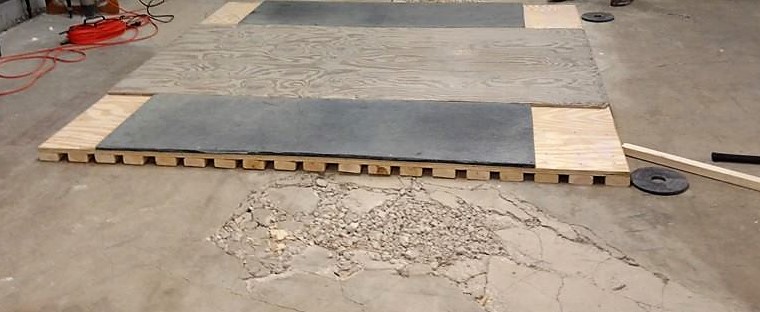
source: reddit thread
It’s the shock load that’s the problem. Anything dropped onto the surface will create a shock load many times the weight being dropped. We see that with power racks too, the safety bars or barbell being damaged when you drop a loaded barbell at freefall a couple feet onto the safety bars. At some point it doesn’t matter how strong it is; something has to give.
A set of 3/4″ rubber mats is good in that it absorbs some of the force, but it only spreads out the force a little bit. That’s where a platform comes in. Wood is rigid and will spread the force out.
It follows that a larger platform of 8’x8′ will spread and absorb more of the force than a 8’x6′ platform.
For Luxury Lifting or Competition Training
The professional way to do olympic lifts is standing on a wood platform. In the Olympic Games, they have a high quality platform set up where the entire top surface is wood. That’s rough on most wood. You won’t likely get away with that yourself long-term.
Still, wood is best to stand on for its stability and the perfect smooth traction. Olympic weightlifting shoes are made to be used on wood floors, letting your feet slide just enough to shift into position, without undue slipping. Therefore, a platform has a wooden middle section and rubber sides to cushion the blow of the plates, giving you the best of both worlds.
What’s the Standard Size Olympic Lifting Platform?
You’ll normally see three standard weightlifting platform dimensions: 8’x4′, 8’x6′, and 8’x8′. So they are all 8ft wide and vary only in the distance from front to back.
- 4ft Deep: Perfectly adequate as a deadlift platform. The bar isn’t travelling high. You don’t need a lot of space.
- 6ft Deep: Minimally adequate for olympic lifting. You can potentially run out of room, causing the bar to roll off the platform.
- 8ft Deep: Optimal size for olympic lifting. Lots of space to work in, no matter if you drop the bar in front of or behind you. This is also the best size for maximum protection of the concrete floor, with the larger wood area spreading out the shock load so that each square footage of concrete can take less of the load.
The 8ft (minimum) width on all platforms is necessary to fit a fully loaded 7ft bar with some wiggle room.
The thickness varies, but it isn’t really a platform unless it’s more than one 3/4″ layer of rubber and/or wood. Two or more layers qualifies as a platform, in my mind, and with that it can vary from 1″ to 2.25″ thick.
Do You Need Bumper Plates?
Generally, you should be using bumper plates when doing olympic lifts on a platform, to prolong the life of everything.
The exception would be if you’re using relatively light weight (whatever “light” is for you) to the point where you are in control of every rep and lower the weight to the floor without dropping it. In this case, iron plates will be fine, but in this case you also don’t need a platform.
Rip illustrates this point:
Deadlifts, on the other hand, don’t require bumpers. Powerlifting meets involve steel discs (which are calibrated very accurately for weight, something you just can’t do as well with cast iron) used on their platforms. It’s still not a bad idea to use bumpers for deadlifts. You’ll protect your equipment better.
Can You Put a Platform on a Wood or Carpeted Floor?
If you have anything but a concrete subfloor, you’re rolling the dice. Light to moderately heavy deadlifts might be ok, or cleans if you lift far under your max and won’t be dropping it. A wood floor or carpeted wood floor, as in your home, isn’t going to be happy when you drop olympic lifts from shoulder height or above, even with the platform. Even a halfway dropped deadlift will shake the room, despite the platform.
With a concrete subfloor, you can place the platform either directly onto the concrete, or ideally, onto rubber flooring between it and the concrete (even 3/8″ rubber is fine) to cut the noise and vibration better.
How to Use a Power Rack and Platform Together
A platform and power rack makes for a versatile setup where you can do presses, squats, deadlifts, and olympic lifts, all in one area, plus all the other exercises you can do with various power racks.
There are two ways to do this:
- Use an Inset
An inset is a fitted piece of wood that fits inside of your rack, with the rest of the platform right in front of the rack. This gives you a smooth transition of wood flooring from the outside to the inside of the rack. - Mount the Rack to the Platform
Leave some space in front for doing lifts outside the rack, directly off the platform. This works fine as a deadlift platform. For olympic lifting it’s not a good idea, because the rack sucks up so much platform space.
The main benefit of mounting the rack to the platform is to secure the rack from tipping or wobbling. Open-ended racks (with no lower cross-brace) are made to be mounted, whether into a platform or concrete floor. Mounting it into a platform saves your nice concrete.
Rogue’s Rubber Tile Platform Kit
Rogue’s modular “build-your-own” platform kit comes in a 8’x6′ size with rubber tiles starting at $935.00, or the 8’x8′ size for a little more. I love things that you can take apart and actually move, and good luck moving a regular solid platform on your own. Basically with Rogue’s solution you buy the frame and a set of 1.5″ thick rubber tiles to stick in it. Done!
Another advantage of Rogue’s is you don’t have to ever worry about wood curling over time. There’s no glue or screws in the construction. The bolted steel frame keeps it all together, and that’s that. There’s not much to it. If you really want to, you could replace the center rubber tiles with two layers of 3/4″ plywood.
On the negative side, the bolts sticking into the steel frame prevents the tiles from being able to snug up against the inside of the frame, instead against only the bolts, causing some other tiles to shift around a little that aren’t restricted by a bolt. The frame was designed a little extra wide with this in mind.
Also, the flat steel frame braces underneath the rubber tiles cause the tiles in those locations to bulge up.
Valor Fitness Olympic Weightlifting Platform
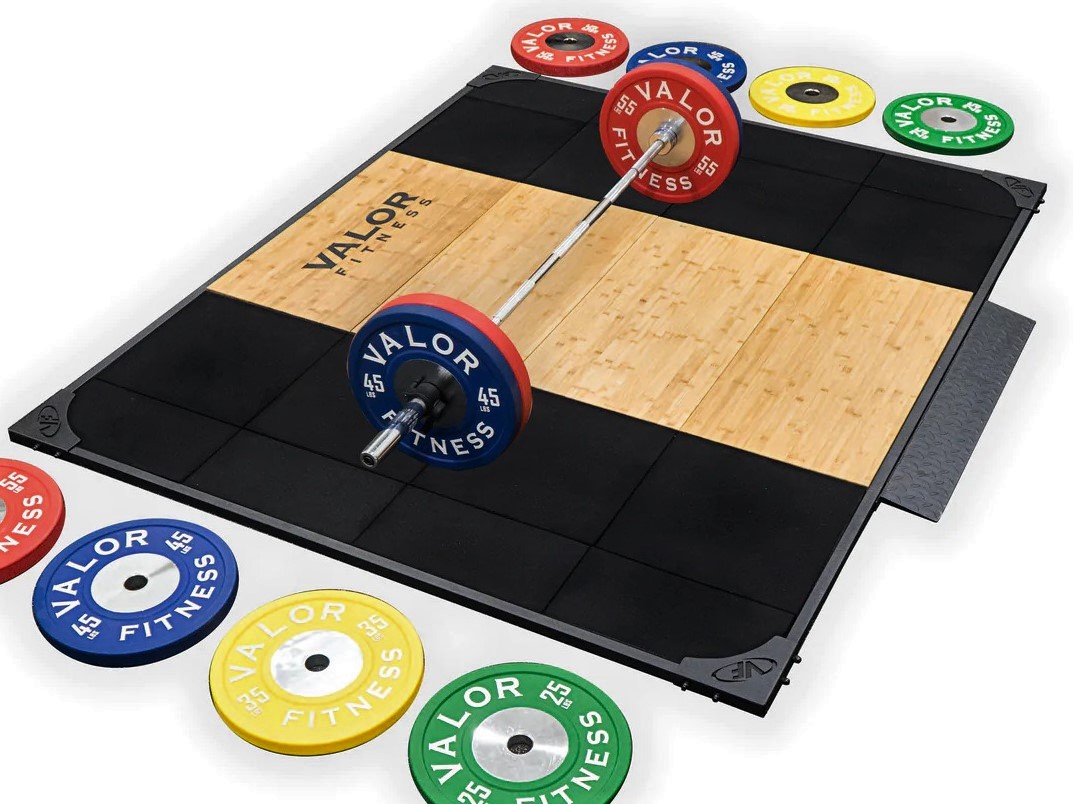
Valor has this more traditional wooden platform design for only $1,139.
It measures 6’11” deep x 8’5″ wide x 1.25″ thick, bigger in every dimension than Rogue’s 6’x8′ platform further above. If this size will work for you, Valor’s platform looks to me to be superior in every way. No issues with frame braces underneath the tiles causing bulging, because here they rely on the wood to provide the rigidity instead.
The wood area is “bamboo lined”, meaning the bottom layer is most likely plywood to save on cost, which is fine. The bamboo on top gives you smoother footing.
As far as a rock-solid, fully-constructed platform, all screwed/glued together, you’ll see some listed for $3,000 or so. York has a pretty good one that I sold several of when I ran a store. They charge shipping, which of course is going to be a lot nowadays for something like this. I recommend avoid getting a custom vinyl logo done with them because their polyurethane coating is not enough to protect it.

